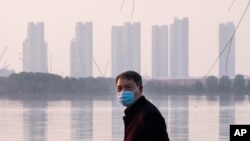The European Space Agency (ESA) has noted a positive effect of the world-wide coronavirus outbreak, saying satellite data is showing reduced air pollution in areas hardest hit by the virus.
The agency says a space observation satellite detected significantly lower levels of the air pollutant nitrogen dioxide (NO2) in in northern Italy and China’s Hubei province.
The ESA’s director of earth observation programs, Simonetta Cheli, says, certainly the reduction in human activity in those areas certainly played a role in reducing the pollutant. But she said the weather and how much heating is done in a given region over a period of time can also be a factor.
Cheli says NO2 is a short-lived pollutant, staying in the atmosphere generally less than a day before being deposited or reacting with other gases. Most emissions are generated by human activities such as traffic, energy production, residential heating and industry.
The ESA’s Sentinel-5P iatmosphere monitoring carries a "Tropomi" instrument, which maps a multitude of trace gases, including nitrogen dioxide, ozone, formaldehyde, sulphur dioxide, methane, carbon monoxide and aerosols.
Jeff Custer contributed to this report.





